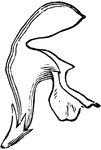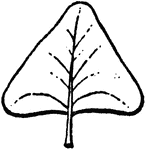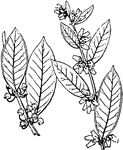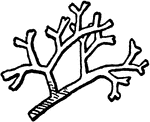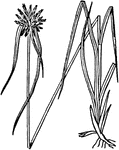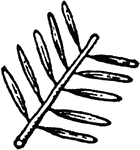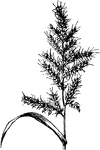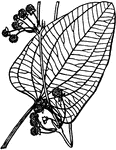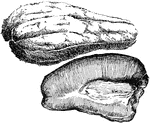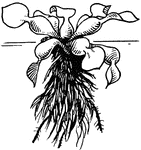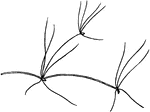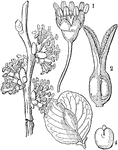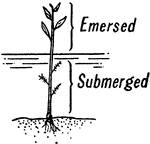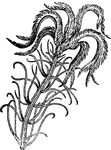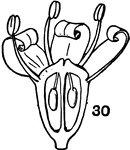
Decurrent
Extending or running down on another structure, as a leaf on a stem or a tubercle on an achene.
Pteris Denticulata
A slightly-toothed fern with fronds ranging between 1 foot and 2 feet in length. It is a long and slender…

Branch of Desert Fan Palm
Also known as Washingtonia filifera. A palm tree native to the desert oases of the southwest United…
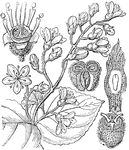
Deutzia
"Deutzia crenata. 1. a flower with the petals removed; 2. a fruit; 3. a portion of the same, showing…
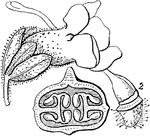
Devil's Claw
"Martynia lutea. 1. a flower; 2. the pistil; 3. a section of its ovary." -Lindley, 1853
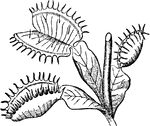
Dionaea
"A very curious and interesting genus of plants of the natural order Droseraceae, having a 5-partite…

Diplopterys
"Diplopteris paralias; 1. a flower-bud, showing the double glands of the calyx; 2. an expanded flower;…

Dipterocarpus
"Dipterocarpus trinervis. a an anther; b a perpendicular, c a transverse, section of an ovary; d a fruit;…

Dodder
"Cuscuta verrucosa. 1. ovary and calyx; 2. section of do.; 3. its fruit; 4. section of a seed of a Cuscuta;…

Greater Dodder
"Corolla, scales and stamens of, 1. Cuscuta europaea; 2. Cuscuta trifolii." -Lindley, 1853

Dogwood
"Benthamia japonica. 1. a flower; 2. a perpendicular section of the pistil; 3. a head of fruit; 4. a…
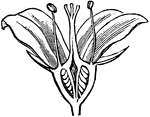
English Dogwood
The English Dogwood (Philadelphus coronarius) is a deciduous shrub, here showing its epigynous stamens…

Dorian
The dorian (Durio zibethinus) is the fruit of the dorian tree in the Bombacaceae family. The fruit is…
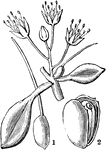
Doveweed
"Eremocarpus setigerus. 1. a young pistil; 2. a ripe fruit after dehiscing." -Lindley, 1853
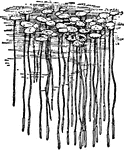
Duckweed
An illustration of duckweed. Duckweed is an important food source for waterfowl and are eaten by humans…

Duckweed
An illustration of duckweed. Duckweed is an important food source for waterfowl and are eaten by humans…

Duckweed Inflorescence
An illustration of duckweed inflorescence containing two male flowers each of one stamen and a female…

Dumontier's Fan
"The form of Dumoutier is merely a refinement on the Montreuil method. The formation of the tree commences…
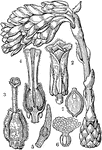
Dutchman's Pipe
"Monotropa Hypopithys. 2. a flower; 3. a pistil; 4. the same divided perpendicularly; 5. a seed; 6.…

Mottled Dutchman's Pipe
"Aristolochia galeata. 1. fruit of an Aristolochia; 2. cross section of it; 3. half its seed." -Lindley,…

Branch of Eastern Black Oak
Also known as Quercus velutina. The branch of an Eastern Black Oak tree, native to eastern North America.

Branch of Eastern Cottonwood
Also known as Populus deltoides. The branch of an Eastern Cottonwood, native throughout the eastern,…

Branch of Eastern Red Juniper
Also known as Juniperus virginiana. Native throughout the United States.
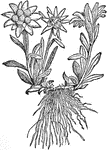
Edelweiss
Edelweiss (Leontopodium alpinum) is a European mountain flower of the Asteraceae or daisy family.
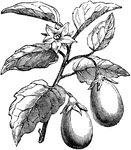
Eggplant
The Eggplant (Solanum melongena) is a flowering plant in the Solanaceae family of nightshades. Its fruit…
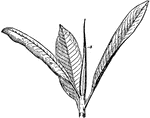
Indian Rubber Fig Ficus Elastica Shoot
An indian Rubber Fig, Ficus Elastica, shoot. The stipule, s, is shown to illustrate a new leaf growth…
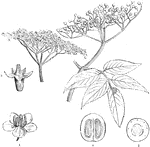
Elder
"Sambucus nigra; 1. a flower; 2. a young pistil; 3. a cross section of its ovary; 4. a perpendicular…
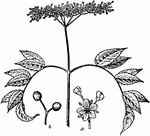
American Elderberry
"Branch with Inflorescence of Elder (Sambucus Canadensis). (a), part of the inflorescence; (b), fruits."…

Polypodium Vulgare Elegantissimum
An elegant form of the Polypodium vulgare. The fronds are very finely divided.
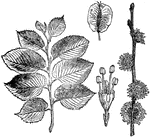
English Elm
Now known as Ulmus procera, the image shows a "Flowering Branch and Foliage of English Elm (Ulmus campestris),…

Branch of Emory Oak
Also known as Quercus emoryi. The branch of an Emory Oak tree, native to the southwestern United States.

Silver Emubush
"Pholidia scoparia. 1. a corolla opened; 2. perpendicular section of ripe fruit; 3. cross section of…
